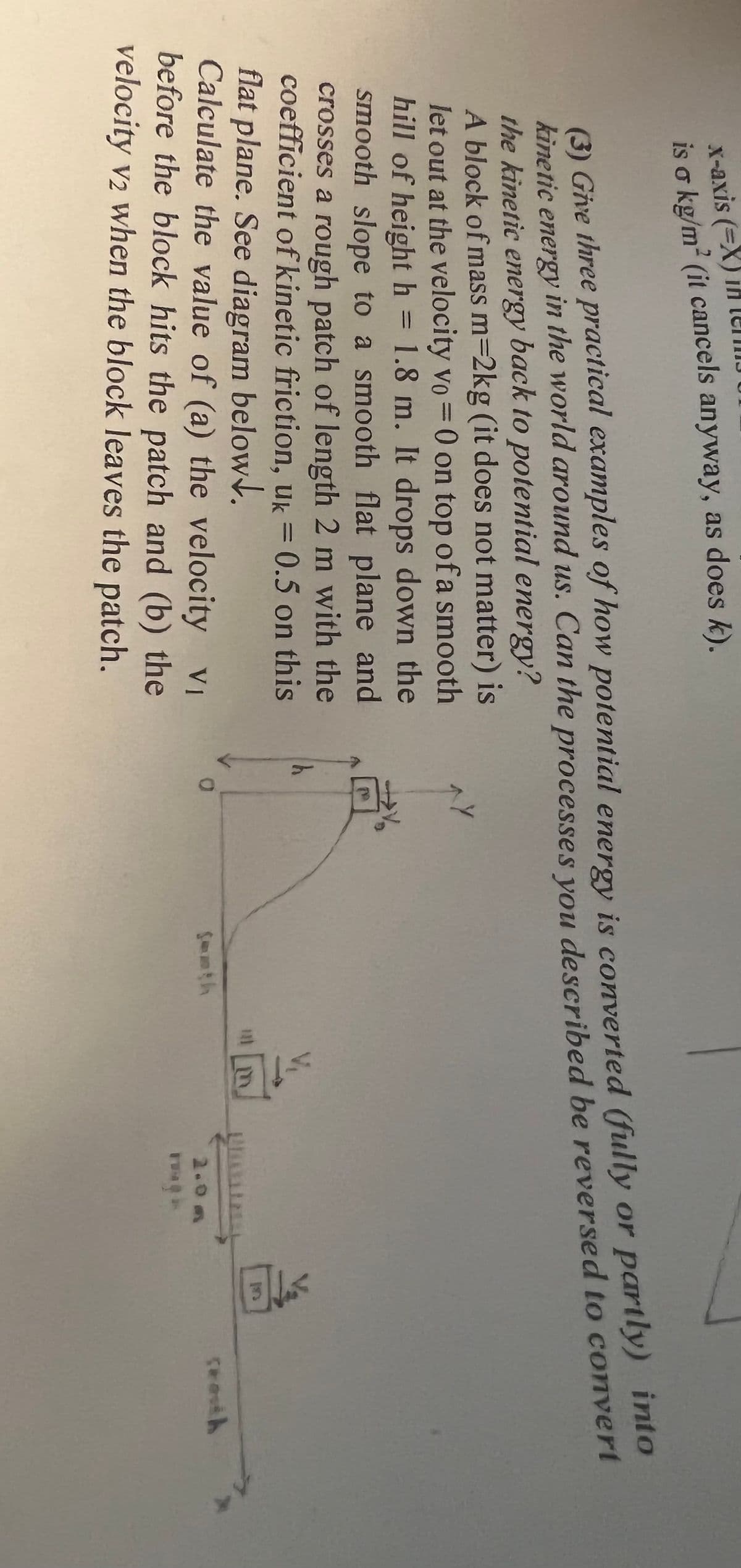(3) Give three practical examples of how potential energy is converted (fully or partly) into kinetic energy in the world around us. Can the processes you described be reversed to convert the kinetic energy back to potential energy? 1 A block of mass m=2kg (it does not matter) is let out at the velocity vo = 0 on top of a smooth hill of height h = 1.8 m. It drops down the smooth slope to a smooth flat plane and crosses a rough patch of length 2 m with the coefficient of kinetic friction, uk = 0.5 on this flat plane. See diagram below. Calculate the value of (a) the velocity VI before the block hits the patch and (b) the velocity v2 when the block leaves the patch. h 2.0m TE cath
(3) Give three practical examples of how potential energy is converted (fully or partly) into kinetic energy in the world around us. Can the processes you described be reversed to convert the kinetic energy back to potential energy? 1 A block of mass m=2kg (it does not matter) is let out at the velocity vo = 0 on top of a smooth hill of height h = 1.8 m. It drops down the smooth slope to a smooth flat plane and crosses a rough patch of length 2 m with the coefficient of kinetic friction, uk = 0.5 on this flat plane. See diagram below. Calculate the value of (a) the velocity VI before the block hits the patch and (b) the velocity v2 when the block leaves the patch. h 2.0m TE cath
Principles of Physics: A Calculus-Based Text
5th Edition
ISBN:9781133104261
Author:Raymond A. Serway, John W. Jewett
Publisher:Raymond A. Serway, John W. Jewett
Chapter6: Energy Of A System
Section: Chapter Questions
Problem 52P
Related questions
Topic Video
Question

Transcribed Image Text:x-axis (=X) in
is o kg/m² (it cancels anyway, as does k).
(3) Give three practical examples of how potential energy is converted (fully or partly) into
kinetic energy in the world around us. Can the processes you described be reversed to convert
the kinetic energy back to potential energy?
A block of mass m=2kg (it does not matter) is
let out at the velocity vo = 0 on top of a smooth
hill of height h = 1.8 m. It drops down the
smooth slope to a smooth flat plane and
crosses a rough patch of length 2 m with the
coefficient of kinetic friction, uk = 0.5 on this
flat plane. See diagram below.
^y
Calculate the value of (a) the velocity VI
before the block hits the patch and (b) the
velocity v2 when the block leaves the patch.
1E
2.0m
Expert Solution
This question has been solved!
Explore an expertly crafted, step-by-step solution for a thorough understanding of key concepts.
Step by step
Solved in 5 steps

Knowledge Booster
Learn more about
Need a deep-dive on the concept behind this application? Look no further. Learn more about this topic, physics and related others by exploring similar questions and additional content below.Recommended textbooks for you

Principles of Physics: A Calculus-Based Text
Physics
ISBN:
9781133104261
Author:
Raymond A. Serway, John W. Jewett
Publisher:
Cengage Learning

Classical Dynamics of Particles and Systems
Physics
ISBN:
9780534408961
Author:
Stephen T. Thornton, Jerry B. Marion
Publisher:
Cengage Learning

Principles of Physics: A Calculus-Based Text
Physics
ISBN:
9781133104261
Author:
Raymond A. Serway, John W. Jewett
Publisher:
Cengage Learning

Classical Dynamics of Particles and Systems
Physics
ISBN:
9780534408961
Author:
Stephen T. Thornton, Jerry B. Marion
Publisher:
Cengage Learning